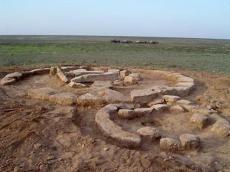Today.Az » World news » Absheron's Bronze Age historical monuments
25 August 2022 [16:53] - Today.Az

By Azernews By Sabina Mammadli The Absheron Peninsula carries traces of history within itself, parts of which are reflected in ancient mounds belonging to the Bronze Age discovered in the area. As local media portal Azerhistory reports, the ancient mounds have been found almost throughout the entire territory of Absheron, but they were mostly concentrated in the north and northeast of the peninsula. In particular, some mounds near the village of Turkan and Dubandi station have been relatively well studied. At the beginning of the XXI century, historian and amateur archaeologist Abbas Islamov discovered numerous low hills near Turkan. On one of them, large blocks of stone appeared through the soil. It was decided to start excavations in this very place and in September 2004, a group of enthusiasts led by a professional archaeologist, an employee of the National Academy of Sciences of Azerbaijan, Idris Aliyev, set to work. The excavations resulted in the discovery of two about two meters long large blocks. They had an anthropomorphic shape. In the upper part of one of the figures, a head and chest were clearly visible. Further, the remains of a ceramic vessel were found near the southern edge of the mound. Aliyev believed that the ceramics belonged to the Maikop culture and dated back to the Bronze Age. After clearing the soil layer around the figures, a cromlech was exposed – a perfect circle with a diameter of 9 meters, lined with hewn and tightly fitted stones. Later, at the southern edge of this circle, another adjoining cromlech was discovered. The diameter of this stone circle is about 4 meters. Further, it was observed that the two cromlechs were laid out in the form of figure eight. The archeologists estimated that the monuments were similar to the Maykop mounds and dated back to the 3rd-2nd millennium BC. Further discoveries in the area include a different type of mound found in the village of Turkan. It was a stone circle with a stone chamber in the center. The space between the camera and the circle was filled with cobblestone. The central chamber measuring 1.2 m by 0.8 m was empty. The mound was built about 5,000 years ago. At the end of the 1980s, in the vicinity of Dubandi station, another group of stone mounds was discovered. They were also believed to belong to the III-II millennium BC. These mounds are included in the list of archaeological monuments of Azerbaijan. One of these mounds, discovered 800 meters northeast of the Dubandi railway station, was explored in 1987. As a result of excavations, ceramic vessels, various ornaments in the form of beads, etc. were found here. The mound dates back to the beginning of the 2nd millennium BC. Another mound was investigated in 1988. It is a cromlech laid out of stone slabs in several rows with a single burial in the center. Ceramics and bronze, found on the mound, are typical of the monuments of the Maikop culture. Not far from the area, the remains of an ancient quarry were discovered, where, evidently, the stone was mined for the cromlechs. To do this, wedges were driven into the rocky ground, with the help of which relatively flat stones were broken off. After some processing, the stones were used in construction. Such surface quarries were found both in the immediate vicinity of the barrows and several hundred meters away from them.
|